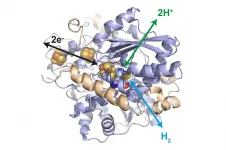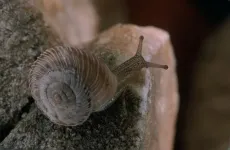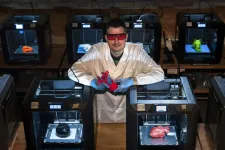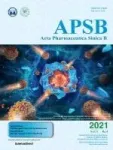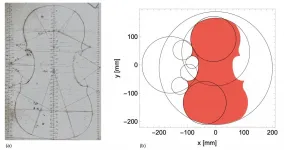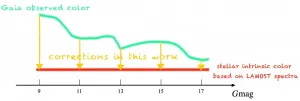(Press-News.org) A giant mosasaur from the end of the Cretaceous period in Morocco that could have reached up to eight metres long is the third new species to be described from the region in less than a year, bringing the total number of species up to at least 13.
The high diversity of the fauna shows how mosasaurs, giant marine lizards related to snakes and Komodo dragons, thrived in the final million years of the Cretaceous period before they, and most of all species on Earth, were wiped out by the impact of a giant asteroid 66 million years ago.
The new species, named Pluridens serpentis, had long, slender jaws with over a hundred sharp, fanglike teeth to grab small prey like fish and squid. Compared to related species, it had small eyes, suggesting poor vision. But the snout had dozens of openings for nerves, hinting at the ability to hunt by sensing water movements and changes in pressure. These nerves may have been sensitive to tiny variations in water pressure, an adaptation seen in sea snakes.
"Typically, when animals evolve small eyes, it's because they're relying more heavily on other senses," said Dr Nick Longrich, senior lecturer at the Milner Centre for Evolution at the University of Bath, who led the study.
The fact that Pluridens had so many nerves in the face may mean that it was using changes in water pressure to detect animals in low-light conditions, either at night or in deep, dark water. Mosasaurs may also have had other senses at their disposal.
"If it wasn't using the eyes, then it's very likely that it was using the tongue to hunt, like a snake," he said. "Many aquatic snakes and lizards - sea snakes, filesnakes, water monitors- flick their forked tongues underwater, using chemical cues to track their prey. Mosasaurs would have resembled whales and dolphins, so it's tempting to assume they lived like them.
"But they're very different beasts - they're huge lizards - so they probably acted like them."
While most of its relatives were small, just a few meters long, Pluridens got big, perhaps eight meters long. The largest individuals had thick, heavily built jawbones.
"It's possible that big males were fighting with these jaws," said Dr Longrich. "In some beaked whales, the males have massive jaws they use to fight with, and male sperm whales can be highly aggressive. Some Pluridens jaws show healing injuries, which suggests some violent fights."
The Moroccan mosasaurs were wildly diverse. Some had small teeth for seizing fish and squid, others evolved blunt teeth to crush crustaceans, clams, and ammonites, while others had teeth designed to cut or tear apart other marine animals - including other mosasaurs.
Pluridens brings the number of mosasaurs known from latest Cretaceous of Morocco up to 13, but the researchers suggest it's unlikely to be the last new species.
Dr Longrich said: "The diversity in these fossils is just astonishing. Far from declining in diversity, the mosasaurs seem to be peaking just before they went extinct.
"We're not seeing any evidence that this group was struggling before they went extinct - From an evolutionary standpoint, they were succeeding, they did everything right- but nothing can prepare you for an asteroid."
Co-author on the study, Dr Nour-Eddine Jalil from the Natural History Museum of Sorbonne University (France) said: "It's a new species of a large predator which, with its eight metre length, comes to confirm the diversity of the faunas of the seas just before the Cretaceous crisis.
"Pluridens serpentis highlights the importance of the paleontological heritage of Morocco to help illustrate the history of life."
Dr Nathalie Bardet, a specialist in mosasaurs, particularly those from the Phosphates of Morocco, at the Muséum National d'Histoire Naturelle of Paris, was also co-author on the paper.
She said: "Working on this group of marine reptiles since more than 20 years, I never stop being surprised by the incredible diversity of these predators, who all lived there and shared the available space and food resources.
"These latest discoveries show perfectly that the list of species present here is far from being closed and that the future still holds great surprises and discoveries!"
INFORMATION:
The study, done in collaboration with researchers from Natural History Museum of Sorbonne University (France), the Office Chérifien des Phosphates (OCP) and University Cadi Ayyad (Morocco), is published in Cretaceous Research.
Modern vaccines such as those against Sars-CoV-2 use tiny lipid spheres to transport genetic information into cells and let the body build up an immune defense against the virus. A team of scientists from Erlangen, Dresden, and London has now developed a completely new method to very efficiently deliver not only genes but also drugs and other substances into cells. The researchers from the Max-Planck-Zentrum für Physik und Medizin (MPZPM) in Erlangen, the Technical University of Dresden, and The Institute of Cancer Research in London have named the method Progressive Mechanoporation and have now published it in the scientific journal "Lab on a Chip". They have also filed a patent.
Ruchi Goswami and Alena Uvizl were part of a team of scientists led by Salvatore Girardo (Erlangen) ...
An enzyme could make a dream come true for the energy industry: It can efficiently produce hydrogen using electricity and can also generate electricity from hydrogen. The enzyme is protected by embedding it in a polymer. An international research team with significant participation of scientists from Technical University of Munich (TUM) has presented the system in the renowned science journal Nature Catalysis.
Fuel cells turn hydrogen into electricity, while electrolysers use electricity to split water to produce hydrogen. Both need the rare and thus expensive precious metal platinum as a catalyst. Nature has created a different solution: Enzymes, referred to as hydrogenases. ...
Experts in virtual reality locomotion have developed a new resource that analyses all the different possibilities of locomotion currently available.
Moving around in a virtual reality world can be very different to walking or employing a vehicle in the real world and new approaches and techniques are continually being developed to meet the challenges of different applications.
Called Locomotion Vault, the project was developed by researchers at the Universities of Birmingham, Copenhagen, and Microsoft Research. It aims to provide a central, freely-available ...
A study published in the journal Scientific Reports reveals the genetic structure of the land snail Xerocrassa montserratensis and it provides new scientific tools for the improvement of the conservation of this endemic and threatened species in Catalonia. This land mollusc, identified in the late 19th century in the Montserrat mountain, has a reduced geographical distribution limited to the province of Barcelona, and it is a protected species in the area of the natural parks of Montserrat and Sant Llorenç del Munt i l'Obac.
The study is led by the lecturer Marta Pascual, from the Faculty of Biology and the Biodiversity Research Institute of the University of Barcelona ...
Skeletal muscles make a tremendous variety of actions stabilizing the body in different positions. Despite their endurance during daily activities, they can undergo several mild injuries caused by sport, accidental overstretching, or sudden overtwisting. Luckily mild injuries can be quickly healed; however, when a large part of muscles is damaged or resected surgically, the full recovery can be impossible. Muscle regeneration is challenging, but the development of innovative biocompatible materials tackles that problem. Recently, a multinational team of scientists led by dr. Marco Costantini from ...
Acta Pharmaceutica Sinica B Volume 11, Issue 4 Publishes
https://www.sciencedirect.com/journal/acta-pharmaceutica-sinica-b/vol/11/issue/4
Special Issue: The Biological Fate of Drug Nanocarriers
This special issue includes seven review and nine research articles from some leading scientists in the field that further the discussion on subtopics of in vivo fate of drug nanocarriers.
Guest Editors: Wei Wu, Professor, Department of Pharmaceutics, School of Pharmacy, Fudan University, Shanghai, China; Tonglei Li, Professor, Department of Industrial & Physical Pharmacy, Purdue University, West Lafayette, IN, USA; Ying Zheng, Professor, State Key Laboratory of Quality Research in Chinese Medicine, Institute of Chinese Medical Sciences, University of Macau, Macau, China.
The Journal ...
How to predict the sound produced by a tonewood block once carved into the shape of a violin plate? What is the best shape for the best sound? Artificial Intelligence offer answers to these questions.
These are the conclusions that researchers of the Musical Acoustics Lab of Politecnico di Milano presented in a study that was recently published in Scientific Reports.
In the article "A Data-Driven Approach to Violinmaking" the Chilean physicist and luthier Sebastian Gonzalez (post-doc researcher) and the professional mandolin player Davide Salvi (PhD student) show how a simple and effective neural network is able to predict the vibrational be-havior of violin plates. This prediction is obtained from a limited set of geometric and mechanical ...
The Large Sky Area Multi-Object Fiber Spectroscopic Telescope (LAMOST) has helped Gaia achieve millimagnitude (mmag) precision in photometry, according to a study led by researchers from National Astronomical Observatories of Chinese Academy of Sciences (NAOC) and Beijing Normal University (BNU).
Their study was published in The Astrophysical Journal.
If you look at the sky on a clear, starry night, you may notice that Aldebran is relatively red and Rigel is blue. Why? The answer stems from their intrinsic physical properties. Precisely measuring magnitudes ...
The polar vortex is a large area of upper-atmosphere cyclonic air circulation surrounding both poles. It is bounded by the polar jet stream and its associated cold air is usually confined to the polar regions. Within the Antarctic circle, and southern polar vortex, ozone quantities are the lowest, globally. A research published in Advances in Atmospheric Sciences, led by Dr. LUO Yuhan, corresponding author and Associate Professor at the Hefei Institutes of Physical Science (HFIPS), suggests that the polar vortex plays a key role in Antarctic stratospheric ozone depletion.
"The atmosphere over Antarctica is controlled by a strong ...
May 1, 2021 - Rheumatologists in Hong Kong joined hands to develop a set of consensus statements on COVID-19 vaccination for local adult patients with autoimmune rheumatic diseases. These timely statements would serve to be a guide for rheumatologists, other specialists, family physicians, specialty nurses, and the public regarding COVID-19 vaccination for patients with rheumatic diseases.
Vaccination against SAR-CoV-2 is a new campaign and a high immunization rate is believed to be the key to end the pandemic. Currently, there are two COVID-19 vaccines available in Hong Kong--the inactivated virus vaccine CoronaVac® ...

